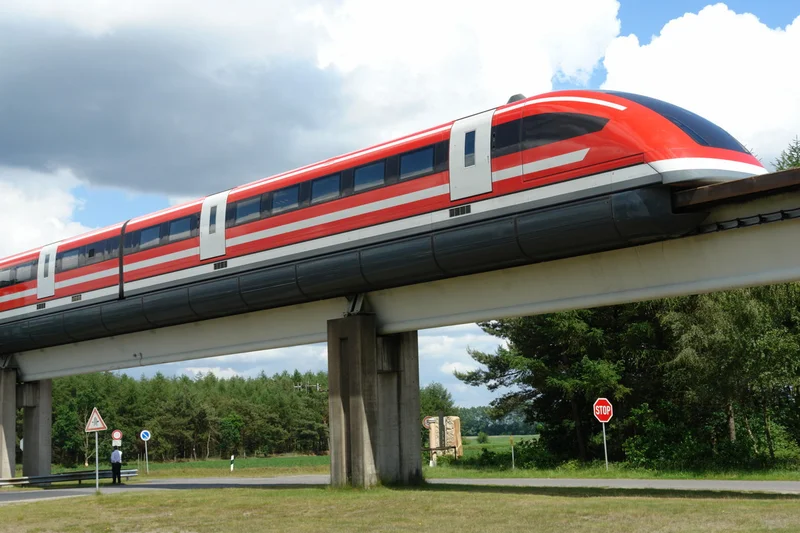Maglev Hype Train: Is This Really the Future, or Just an Expensive Toy?
The Promise of Magnetic Levitation
Maglev trains. The name itself conjures images of futuristic travel, silently gliding at speeds that make conventional rail seem like horse-drawn carriages. The promise is compelling: reduced friction, higher speeds, lower maintenance. Test runs hitting 600 kilometers per hour. Operational systems in China moving passengers at 430 km/h. The numbers are impressive. But let's dig a little deeper.
The core concept is undeniably elegant. Using magnets to levitate the train above the track eliminates the friction that limits traditional trains. Two main types of systems exist: electromagnetic suspension (EMS), which uses electromagnets to pull the train up, and electrodynamic suspension (EDS), which uses repulsive magnets to push it away. Both achieve the same goal: frictionless travel. Propulsion is achieved similarly, using magnetic fields to pull and push the train forward. No wheels, no grinding, just smooth, silent motion.
The Reality Check: Maryland's Maglev Debacle
While the technology is fascinating, the practical application has been… less than stellar. The recent cancellation of the Baltimore-Washington maglev project is a stark reminder of the challenges involved. The Federal Railroad Administration deemed the project "no longer feasible," citing "substantial negative effects to agency operations or to important resources managed by federal agencies." The estimated capital cost? Nearly $20 billion. Feds pull plug on Baltimore-DC maglev train project
Transportation Secretary Sean P. Duffy put it bluntly: "This project lacked everything needed to be a success from planning to execution. This project did not have the means to go the distance, and I can’t in good conscience keep taxpayers on the hook for it."
Now, let's unpack that. $20 billion is a hefty price tag. For comparison, the recently completed California High-Speed Rail project (still under construction, but let's pretend) has a projected cost of around $100 billion for the entire route from San Francisco to Los Angeles (though that figure is, shall we say, optimistic). The Baltimore-Washington route is significantly shorter. So, what went wrong?
The FRA cited "substantial impacts to federal agencies and federal properties." This suggests a failure to adequately address logistical and political hurdles. Building any large infrastructure project involves navigating a complex web of regulations, permits, and stakeholder interests. The Maryland project seems to have stumbled badly.
One has to wonder: were the potential benefits of the project (faster travel times, reduced congestion) realistically weighed against the costs and risks? Or was this a case of technological infatuation blinding decision-makers to practical realities? I've seen this pattern before: shiny new tech gets the green light based on overly optimistic projections, only to crash and burn when faced with real-world constraints. (Remember Webvan? Anyone?).

The company behind the project, Baltimore Washington Rapid Rail, claimed the maglev would have resulted in over $6 billion in private investment and created more than 160,000 jobs. But these figures should always be viewed with skepticism. Economic impact studies often rely on assumptions that may not hold true in practice. (For example, will those "new" jobs simply displace existing ones in other sectors?).
And this is the part of the report that I find genuinely puzzling. If the project was so economically beneficial, why did it fail to garner sufficient political support? Why did multiple state lawmakers sponsor legislation to block state funding? It's unusual for a project with such a supposedly high return on investment to face such strong opposition.
Speed vs. Cost: The Fundamental Trade-Off
The Japanese L0 maglev train is frequently cited as an example of maglev's potential. Footage of reporters reacting in astonishment to its speed is readily available online. It is claimed that the new magnetic bullet train will connect Tokyo and Osaka in just one hour. But let's consider the trade-offs.
The cost of the L0 maglev is estimated at $70 million per carriage. That's a staggering sum. While the speed is undeniably impressive, the economic viability remains questionable. Can such a high-cost system be scaled and deployed in a way that makes sense for the average commuter? Or will it remain a niche technology, reserved for wealthy countries and specific high-demand routes?
The Shanghai Maglev is another oft-cited example. It's the world's first commercial maglev line, connecting Shanghai Pudong International Airport with the city center. The ride is certainly fast and smooth, but the line is relatively short and primarily serves airport traffic. It hasn't revolutionized urban transportation in Shanghai.
The fundamental question is: are the speed and efficiency gains of maglev technology worth the significantly higher infrastructure costs? Building maglev tracks requires entirely new infrastructure. It can't simply be integrated into existing rail networks. This makes maglev projects inherently more expensive and complex than upgrading conventional high-speed rail.
The Hype Doesn't Match the Reality
Maglev technology holds undeniable promise. But the hype surrounding it often obscures the practical challenges and economic realities. The cancellation of the Maryland project serves as a cautionary tale. While maglev may one day transform transportation, it's not a magic bullet. It requires careful planning, realistic cost assessments, and a willingness to confront the logistical and political hurdles involved. Until then, it remains an expensive toy with limited real-world applications.
So, What's the Real Story?
Maglev is a classic case of "cool tech, questionable ROI." The numbers on cost and political feasibility just don't add up yet.
